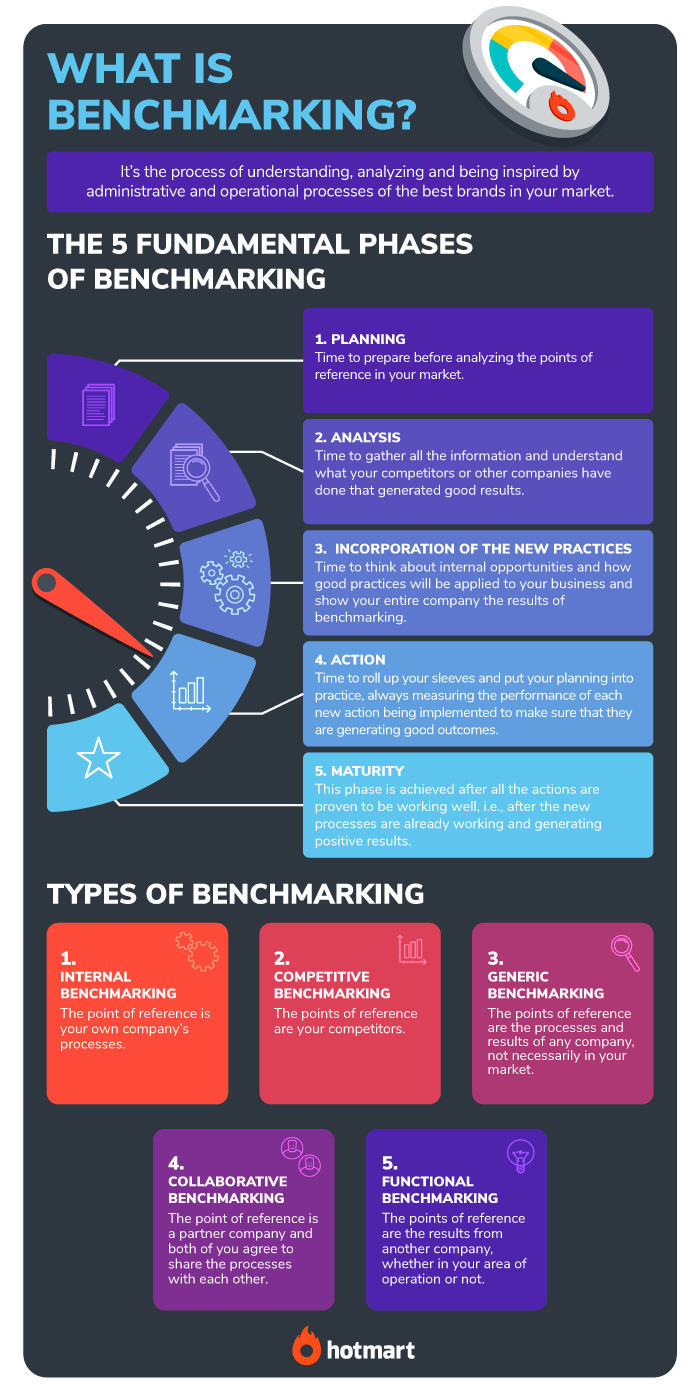
What is benchmarking and how to do it successfully
Understand the concept of benchmarking and learn the 5 phases of this process.

What will we see in this post
For those who are just starting a business or even those who’ve had a business for a while, inspiration is always helpful. Benchmarking allows you to find references that help us identify operational standards that work and that can also be applied to other businesses.
But, how do you find market references in your niche to be inspired by good practices and effective strategies?
Read on and check out how to improve your business’ processes by analyzing your competitors.
What is benchmarking?
Benchmarking is a technique that consists of understanding, analyzing, and being inspired by the administrative and operational processes of the best brands in your market.
But how do you do that?
In short, benchmarking is done through a lot of evaluative research and in certain cases, even closely following a company that is well known in the market.
Benchmarking is a “comparative evaluation” or a “point of reference”. In other words, it’s a way of comparing your efforts with those of other companies in order to improve your business based on the successful strategies of other entrepreneurs.
But, be careful! When we talk about being inspired by what other valuable things people are doing, we don’t mean that you should copy them.
The most important thing in benchmarking is to be able to open your mind and think outside the box, i.e., go beyond what you are already doing.
So, based on the prosperous strategies of other entrepreneurs, you can find improvements for your business, which, without benchmarking, you might’ve never thought would work.
Learn about the 5 phases of the benchmarking process
Now you understand that benchmarking is an exercise in continuous research. It can be done either from the companies or entrepreneurs that you admire or from analyzing your competitors.
Regardless, there are critical 5 phases in the entire benchmarking process, which are:
- Planning of investigations: This is the moment when you prepare to analyze your market’s points of reference. It is during this phase that you need to answer 3 questions: What are the points of reference you seek? With whom do you want to compare your business? Which methodology will you use to collect the data? The planning step must be well prepared so that everything else works well.
- Analysis of what has been investigated: This is the analysis phase, i.e., the moment in which you take all the information collected and understand what your competitors, or companies that you admire, have done better than you.
- Incorporation of the new practices: After the analysis, it’s important to think about how you can apply the good practices you have collected in your business. Show your benchmarking results to your entire company and together, think about how the actions of other entrepreneurs can be incorporated into your routine (without copying, of course).
- Action: This is the time to roll up your sleeves and get to work! Put your planning and everything you analyzed into practice. Don’t forget to measure the performance of each new action implemented to make sure that what you are doing is generating good results. Also, remember to make improvements and adaptations to your actions whenever necessary. After all, the entire process needs to adapt to your business’ reality.
- Maturity: The maturity phase will only be achieved after all actions are working well, i.e., after all the new processes are already working and generating positive results.
Types of benchmarking
There are 5 types of benchmarking and just because you chose one model now it doesn’t mean that you need to exclude the others. On the contrary, you can perform several benchmarks to find new ways of thinking about your business.

1. Internal benchmarking
For this type of benchmarking, you will have your own company’s processes as references. But how so?
Let’s suppose that you have a sales team and a marketing team.
Your sales team might have a well-structured process to communicate with your internal customers. The marketing team, on the other hand, might have some problems talking with your external customers.
Why not take tips from your sales teams and think of a way of communicating internally that will facilitate the marketing team’s job?
Or, you are scaling your business and want to start a new company in another city or even another country.
To do so, it’s very important to perform internal benchmarking so that the processes at your new company can be as successful as your first company’s.
2. Competitive benchmarking
When we talk about competition, we are talking about your competitors.
That’s right, for this type of benchmarking, you will research your competitors’ good practices.
Observe what they have been doing and what is generating good results, and think if these strategies can be valid for your business. But don’t forget that you should only seek inspiration and not copy what others are doing.
3. Generic benchmarking
As the name suggests, this is generic benchmarking, i.e., your point of reference will be the processes and results of any company, not necessarily being part of your area of operation.
For example: Have you noticed how Apple is a reference in launching products?
A good tip is understanding what they do beforehand in order to generate their entire pre-launch boom and use some of these strategies to place your product or service in the market.
4. Collaborative benchmarking
This is also known as cooperative benchmarking. This type of benchmarking takes place when there’s a partnership between two different companies who share their processes.
In collaborative benchmarking, it’s very important to have direct contact with someone from the other company. This way, you can talk and understand each other’s practices or even business models.
5. Functional benchmarking
Finally, in functional benchmarking, which is the most common form of benchmarking, your point of reference will be the other company’s results.
You don’t need to analyze a competitor, but it’s very important that the company used as a point of reference have activities similar to your own.
For example: If you have an online course on healthy meals, you can carry out functional benchmarking with a Producer that has an online course on dog training in order to understand actions such as:
- Marketing campaigns
- Persona survey
- Brand development; etc.
How to benchmark
As you have seen, there are 5 types of benchmarking and each one has its own specificities.
Despite this, when it comes to benchmarking, certain steps are fundamental, and we will talk about them now:
Have a goal
Before you do any benchmark, you need to be very clear about what goal you want to achieve when applying this strategy.
What are the areas in your business that need improvement? What have you seen people do that you haven’t done yet?
After you establish the goal that led you to perform your benchmarking, it will be easier to select which companies you will talk to, which is our next topic.
Choose your point of reference
This might sound silly; after all, the main goal of benchmarking is precisely to understand a company’s processes to see what can be applied in your own business. But believe me, this phase is usually forgotten by many entrepreneurs.
So, even before you start talking to everyone, define who your points of reference will be in order to get in touch with them.
Contact those responsible for each department of the chosen company
Many people find this to be the most difficult part: being able to contact those responsible for each department of the company that will be your point of reference for your benchmark.
It is now that you need to forget your shyness. Good networking is very important in order to get in touch with those with whom you want to talk.
Just be careful not to select too many points of reference. This might make the analysis of the data more difficult.
Establish the indicators for your analysis
Do you remember the goals that you have already set? They will be very important when it comes to selecting the indicators that will be analyzed.
Create a table so you can compare the results of all the companies you analyze quantitatively and qualitatively. Thus, you will have an overall view of what is done, its results, and think about the actions for your business.
Collect the data
There are a few tools that you can use to collect data, such as SimilarWeb and Klout, or those on social media.
There is also the possibility of using the good old Excel, talking to your points of reference, and collecting the data yourself.
Regardless of how you do this, it’s very important to be able to quantify all the indicators that you have selected beforehand to analyze. After all, this will help you understand the strategies of each entrepreneur or company that are working.
Compare the collected data
Do you remember the table we told you to create with all the indicators you wish to analyze? This is the time to compare the results between the companies selected for benchmarking and your own business.
Notice the points in common between all the companies you are analyzing. This will help you identify which strategies probably work better.
Develop an action plan
Finally, don’t forget to develop a plan specifying the actions you must take in order to start implementing the strategies analyzed in your business.
But don’t focus only on what is missing. Also, think about the high points, in what you’re already doing and what works, and try to improve your processes.
In order to help you develop your action plan, we have this post with tips on how to create a marketing plan. Make sure you check it out!




